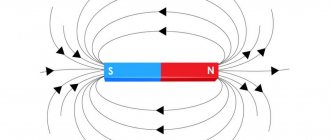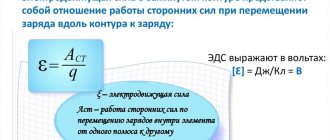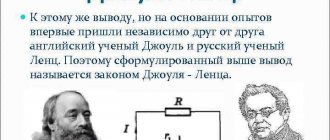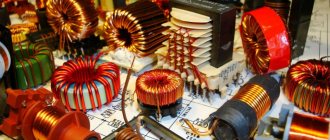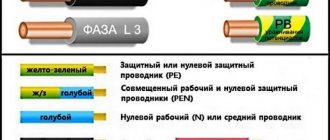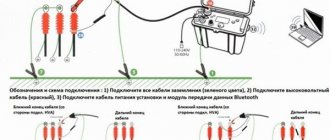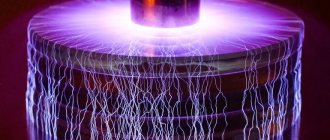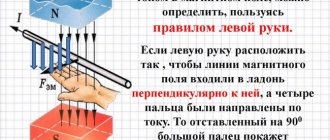Hello. As I promised in the article Electricity. Basic concepts, in this part we will continue our acquaintance with the basics of electrical engineering, this time we will look at the basic electrical laws.
Let's probably start with the basic law in electrical engineering - Ohm's law , discovered in 1826 by the German physicist Georg Ohm. I think many have heard and know about him, but I’ll still remind you:
The current strength of a section of an electrical circuit is directly proportional to the voltage applied to this section and inversely proportional to its resistance.
In formula form it looks like this:
Where
I is the current strength passing through a section of the circuit (measured in amperes);
U – voltage on a section of the circuit (measured in volts);
R – resistance of the circuit section (measured in Ohms);
To better remember Ohm's law, it is very convenient to use this triangle:
To find the desired value, close it with your finger and the remaining two will tell you how to find it. If the values are located at the same level, then they need to be multiplied. If the values are located at different levels, then it is necessary to divide the upper parameter by the lower one.
Concepts and properties of electric current
Electrical laws and formulas are required not only for carrying out any calculations. They are also needed by those who practically perform operations related to electricity. Knowing the basics of electrical engineering, you can logically determine the cause of the malfunction and eliminate it very quickly.
The essence of electric current is the movement of charged particles that transfer electric charge from one point to another. However, with the random thermal movement of charged particles, following the example of free electrons in metals, charge transfer does not occur. The movement of electric charge through the cross section of a conductor occurs only if ions or electrons participate in ordered movement.
Electric current always flows in a certain direction. Its presence is indicated by specific signs:
- Heating a conductor through which current flows.
- Change in the chemical composition of a conductor under the influence of current.
- Exerting force on neighboring currents, magnetized bodies and neighboring currents.
Electric current can be direct or alternating. In the first case, all its parameters remain unchanged, and in the second, the polarity periodically changes from positive to negative. In each half-cycle, the direction of the electron flow changes. The rate of such periodic changes is frequency, measured in hertz
Electrodynamics: concept and subject of study
Definition 1
Electrodynamics is a branch of physics that studies the electromagnetic field (temporary fields that depend on time), as well as its interaction with those bodies that have an electric charge.
The subject of electrodynamics includes the study of:
- connections between magnetic and electrical phenomena;
- electromagnetic radiation, which is considered under various conditions (as free interaction with matter);
- electric alternating current;
- interaction of current with an electromagnetic field (electric current can be considered as a collection of charged particles).
Any magnetic and electrical interaction between charged particles is studied in physics as an action that is carried out through an electromagnetic field, and therefore is also the subject of electrodynamics.
Note 1
Often, the term “electrodynamics” refers specifically to classical electrodynamics, which describes the continuous properties of the electromagnetic field using Maxwell’s system of equations. In order to denote the modern quantum theory of the electromagnetic field, the term “quantum electrodynamics” is used.
Have questions about this topic? Ask a question to the teacher and get an answer in 15 minutes! Ask a Question
Basic current quantities
When an electric current occurs in a circuit, a constant charge transfer occurs through the cross section of the conductor. The amount of charge transferred in a certain unit of time is called current , measured in amperes .
In order to create and maintain the movement of charged particles, it is necessary to have a force applied to them in a certain direction. If this action stops, the flow of electric current also stops. This force is called the electric field; it is also known as electric field strength. It is this that causes a potential difference or voltage at the ends of the conductor and gives impetus to the movement of charged particles. To measure this value, a special unit is used - volt . There is a certain relationship between the basic quantities, reflected in Ohm's law, which will be discussed in detail.
The most important characteristic of a conductor directly related to electric current is resistance , measured in ohms . This value is a kind of resistance of the conductor to the flow of electric current in it. As a result of the influence of resistance, the conductor heats up. As the length of the conductor increases and its cross-section decreases, the resistance value increases. A value of 1 ohm occurs when the potential difference in the conductor is 1 V and the current is 1 A.
Joule-Lenz law
The Joule-Lenz law is a physical law of the thermal action of electric current. Discovered in 1840 independently by James Joule and Emilius Lenz.
The Joule-Lenz law states:
The amount of heat generated in a conductor is directly proportional to the square of the current, the resistance of the conductor and the flow time.
In the form of a mathematical formula, this expression looks like:
Where:
Q is the amount of heat generated by the current (J);
I is the strength of the current passing through the conductor (A);
R is the resistance provided by the conductor (Ohm);
t is the time spent on the passage of current ©;
The Joule-Lenz law in differential form looks like this:
The power of heat released per unit volume of a medium during the flow of electric current is proportional to the product of the electric current density and the electric field value
Where
w is the power of heat release per unit volume;
— electric current density;
— electric field strength;
σ is the conductivity of the medium;
Ohm's law
This law relates to the basic provisions and concepts of electrical engineering. It most accurately reflects the relationship between quantities such as current, voltage, resistance and power. The definitions of these quantities have already been considered; now it is necessary to establish the degree of their interaction and influence on each other.
In order to calculate this or that value, you must use the following formulas:
- Current strength: I = U/R (amps).
- Voltage: U = I x R (volts).
- Resistance: R = U/I (ohm).
The dependence of these quantities, for a better understanding of the essence of the processes, is often compared with hydraulic characteristics. For example, at the bottom of a tank filled with water, a valve with a pipe adjacent to it is installed. When the valve opens, water begins to flow because there is a difference between the high pressure at the beginning of the pipe and the low pressure at the end. Exactly the same situation occurs at the ends of the conductor in the form of a potential difference - voltage, under the influence of which electrons move along the conductor. Thus, by analogy, voltage is a kind of electrical pressure.
The current strength can be compared with the water flow, that is, the amount of water flowing through the cross-section of the pipe over a set period of time. As the pipe diameter decreases, the water flow will also decrease due to increased resistance. This limited flow can be compared to the electrical resistance of a conductor, which keeps the flow of electrons within certain limits. The interaction of current, voltage and resistance is similar to hydraulic characteristics: with a change in one parameter, all the others change.
Energy and power in electrical engineering
In electrical engineering, there are also such concepts as energy and power associated with Ohm's law. Energy itself exists in mechanical, thermal, nuclear and electrical forms. According to the law of conservation of energy, it cannot be destroyed or created. It can only be transformed from one form to another. For example, audio systems convert electrical energy into sound and heat.
Any electrical appliance consumes a certain amount of energy over a set period of time. This value is individual for each device and represents power, that is, the amount of energy that a particular device can consume. This parameter is calculated using the formula P = I x U, the unit of measurement is the watt. It means moving one ampere by one volt through a resistance of one ohm.
Thus, the basics of electrical engineering for beginners will help you understand the basic concepts and terms at first. After this, it will be much easier to use the acquired knowledge in practice.
Basic laws of electrical engineering
Elements of the fundamentals of electrical engineering
Coulomb's Law . The force of interaction between two stationary point charges q 1 and q 2 located at a distance from each other in a homogeneous medium is directly proportional to the size of the charges inversely proportional to the square of the distance
between them 1st
Ohm's
law is valid for circuits of direct and alternating sinusoidal current and relates the resistance values of a circuit element, its current and voltage.
The voltage drop across a section of the circuit is proportional to the current and the resistance value of this section:
at direct current U
-1 g ,
at alternating current U
= I
z .
For example, for an electrical circuit (Fig. 1.1): U
=
1 g Rt .
The generalized
Ohm
law takes place for a circuit (branch)
tn of
direct or alternating current, containing sources of emf £, • and resistance fy or
z ^:
at direct current Imn
£ fy =
Umn
+ 1 £;;
at alternating current Imn
£
zk
«
Umn
+ £ f • ^ where
Umn
is the voltage between the beginning and end of
the tn ;
£ Ef
- algebraic sum of all emfs located in
this branch;
£ rk
— arithmetic sum of all resistances in the branch;
£-Zfc is the geometric sum of all resistances in the branch at alternating current.
From the generalized Ohm's law it follows, in particular, that the voltage at the terminals of the EMF source is equal to the value of the EMF minus the voltage drop across the internal resistance of the source.
Kirchhoff's first
law . The algebraic sum of all currents converging at any node of an electrical circuit is equal to zero .
| For AC circuit: |
Kirchhoff's first law is one of the direct consequences of the law of conservation of energy. For DC circuit:
where are the complex effective values of sinusoidal currents;
— instantaneous current values.
Kirchhoff's second
law . The algebraic sum of the electromotive forces of any closed circuit of an electrical circuit is equal to the algebraic sum of the voltage drops in it .
For DC circuits:
or
For AC circuits:
where eK
_ instantaneous values of EMF variables;
And,-
— instantaneous values of the voltage drop on the passive elements of the circuit;
Ek
— vectors of effective EMF values;
Uf
— vectors of effective values of voltage drops.
The direction of traversing the contour is chosen arbitrarily. EMFs have a plus sign if their direction coincides with the direction of the circuit bypass. Voltage drops have a plus sign if the selected signs of the currents in the circuit branches coincide with the direction of the circuit bypass.
Kirchhoff's and Ohm's laws are also valid for magnetic circuits.
Faraday's law
of electromagnetic induction .
The law connects the EMF induced in an arbitrary circuit or conductor placed in a magnetic field with the rate of change of the magnetic flux of the field or the speed of movement of the circuit or conductor relative to a constant magnetic flux field. EMF is measured in volts (V).
| If the circuit contains G3 turns, then we speak of flow-streamercaptivity contour ; Then |
The electromotive
force e induced in a conductor or circuit is proportional to the rate of change of the magnetic flux F passing through this conductor or circuit , taken with minus sign :
with Faraday's law, the change in current flowing in a circuit with inductance L ,
causes changes in its magnetic flux, which induces an EMF in this circuit, called
self-induction :
mutual induction EMF is induced in one of the magnetically coupled circuits if a change in the current value occurs in the other:
where M
12 — coefficient of mutual induction, H.
The sign (+) is placed when the magnetic fluxes are in opposite directions, and (—) when the directions are consonant.
When a conductor moves in a magnetic field with a constant magnetic flux, an emf is induced in it, V'
where in
— magnetic field induction, T;
/ — conductor length, m;
D—conductor speed, m/s;
a is the angle between the magnetic induction and velocity vectors,
hail
At α = 0
The law of electromagnetic induction is fundamental in nature and underlies the operating principle of all modern electromechanical energy converters: electrical machines, electrical devices, etc.
Lenz's Law : If changing current flows along an arbitrary circuit , then it creates its own changing magnetic flux, inducing a counter - in the circuit directed so as to prevent any change in the current .
The specified back-EMF is also called self- induced .
This circumstance is indicated in the above ratios with a minus sign. Thus, the appearance of self-induction EMF in a current-carrying circuit is possible under two essential conditions: the changing nature of the current and the presence of inductance in the circuit.
This indicates the erroneous views of some authors who believe that the self-induction emf determines the measure of electromagnetic inertia of a circuit element. A measure of inertia is the amount of inductance of a circuit element. Self-induced emf plays an important role in electrical devices.
Joule - Lenz law .
The law determines the measure
of the thermal effect
of electric current.
The amount of heat generated by the current in the conductor is equal to the work done by the electric field to move the charge in time t:
The unit for measuring the amount of heat is the joule
(J).
Since 1 cal = 4.1868 J, and 1 J = 0.24 cal, then the amount of heat measured in calories :
Ampere's law
of electromagnetic forces . The force of mechanical interaction of a conductor current and a magnetic field with induction is directly proportional to the product of magnetic induction the length of the conductor the current strength the conductor where
F is
the interaction force / — conductor length, m;
α is the angle between the magnetic induction and current vectors
Strength of interaction
two fairly long wires
located parallel at a distance α:
where F
— interaction force, N;
I 1 and
I 2 –
currents in wires A
— relative and absolute magnetic permeability.
Faraday's law
of electrolysis .
At a constant current
I passing
through the electrolyte during time
t ,
M is released from the solution ,
proportional to the current and time:
where M
— weight, kg;
To
- electrochemical equivalent of the released substance.
Maxwell's
equations for the electromagnetic field for a linear isotropic medium:
(total current law);
(law of electromagnetic induction);
where N
— vector of magnetic field strength;
E
is
the electric field strength vector;
IN
— magnetic induction vector;
D
— displacement current vector:
UE
=
J
vector of conduction current density;
Y—specific conductivity of the medium;
— relative and absolute magnetic permeability;
- relative and absolute electrical constants.
← Previous | Next → … contents …


